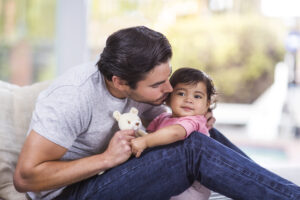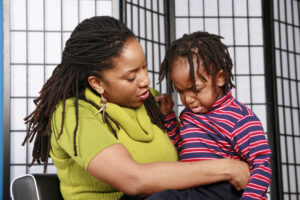
Learning to Tolerate Frustration and Delay Gratification
It’s hard to wait! It can be hard for adults, and it’s even harder for young children. Psychologist Walter Mischel and colleagues have spent decades
How can we improve the fit between ourselves and our child, and between our child and their environments?
Goodness of fit is how well an environment—and the people in it!—match a child’s temperament. Just like that beloved toddler toy, the shape sorter, we can imagine that every child’s temperament has a unique shape that fits well in some spaces, and not so well in others.
The quiet library Damien visits with his auntie every Saturday afternoon is a great fit for him, but the loud, bright-colored new adventure gym is not.
And our own temperament may fit more or less well with our child’s, too!
Maya and her daughter Cecily are both highly active, and love to spend the afternoon playing catch or just about any outdoor games. It’s harder for Maya to sit still with her other child, Jesse, who could build blocks in the same spot for hours.
So it’s also valuable to know and understand our own temperament, along with our child’s. When there’s goodness of fit, it can feel a bit like fitting a cube in just the right square space. Goodness of fit allows a child to experience connection, learning, and challenge with greater ease. And we parents feel more ease, too. When the fit is not so good, it can feel like trying to push that square cube into a triangle-shaped hole.
The good news is that unlike a shape sorter toy, goodness of fit is malleable. We can adapt the environment and our own behaviors to improve goodness of fit for our child. And over time, our parenting choices can help the child adapt to their environments, so that they can:
Exactly how do we improve our child’s goodness of fit?
Adapting our parenting to match each child’s temperament
When children are very young, we can improve goodness of fit for our child by adapting our own behavior and the child’s environment to the child’s temperament. And during this time when they are too young to regulate themselves in the face of a challenging moment, we co-regulate with them. As the child grows, we can learn to support them in stretching their capacity to adapt to their environment, so that they begin to be able to thrive even in environments that aren’t a natural fit for their temperament.
When our child is very young…
All children want to be accepted for who they are, especially babies. And while you can’t manufacture compatibility, you can be attuned and sensitive to the child’s needs. For example, a high-activity parent might dial down for a lower activity child, or a low-activity parent might dial up if the child is more active.
Two examples of adaptation to improve goodness of fit:
Grocery shopping with 20-month-old Zoe often results in a tantrum, especially when Zoe is tired. Sue is embarrassed by Zoe’s outbursts and worries there is something wrong with the child—or that she’s a bad parent. After learning that Zoe is highly sensitive and has a strong reaction to the unexpected, Sue comes to see that the crowds and bustle of a big, busy store may be stressful for Zoe, and fatigue further reduces Zoe’s capacity to self-regulate. Since Sue can’t leave Zoe at home for these errands, she makes a couple of changes that make all the difference: They now shop after Zoe’s nap, during the store’s slower hours. And Sue creates a ritual out of the experience, making the shopping more leisurely, predictable, and playful. The experience becomes a shared ritual they both enjoy so much more.
Natalie has been playing rough with her little brother. Having “tried everything” to change her behavior, her parents realize she is a highly active child who needs more physical activity than she gets at her new preschool. Now they stop by the playground on the way home from school and find that Natalie is able to blow off steam and can play more gently with her brother afterwards.
As our child grows…
We still need to let our child know their temperament is not wrong or bad. This can be difficult if a child’s temperament manifests in behaviors that may draw negative responses from others. Visiting relatives may not like it when a child needs time to warm up to new people, and a parent might wish the child’s temperament were naturally a better fit for the situation.
It helps when we understand the origins of our own reactions to the child’s temperament. Perhaps we too were overwhelmed by new social encounters as children, but we were expected to “be nice” and not ask for what we needed. Or perhaps it’s hard to accept our cautious child because our own reaction to novel people and situations is so unlike our child’s; we may long for more excitement than our current day-to-day provides, and if only our child were different, life could be so much more fun!
When we can recognize our own temperament and our child’s, y especially when we see and understand the roots of our emotional responses to our child’s temperament, we can make more sound parenting choices.
Addressing goodness of fit as a child grows older involves a shift toward supporting the child’s developing regulation of their natural temperament tendencies. The answer is not to arrange the world to be that “perfect” easy fit for the child all the time. A parent who satisfies all of the child’s needs, completely and immediately, robs the growing child of an opportunity to learn age-appropriate behaviors and develop new skills, including the ability to tolerate frustration and delay gratification.
By understanding how your child naturally approaches the world, you can help him or her understand and adapt to different environments, from home to playground to school.
Helping our child learn to adapt.
As our child grows, we can involve them in the process of adaptation by talking through challenging situations and helping the child recognize what works and doesn’t work for them and for others. We can be pro-active and make plans with our child for how they can approach challenges with more and more capacity to regulate their emotions and behavior.
An example of helping a child learn to adapt:
4-year-old Jaden is highly exuberant. His parents love this quality in him—he’s so full of zest! But Jaden’s exuberance can also make it challenging for him to play with other children, and he feels sad when he’s left out. Watching Jaden at the playground, Jaden’s father notices his son sometimes dials up the energy past where the other children seem comfortable. Now, each time they visit the playground, they talk first about watching to see what the other children are doing, and asking if he can join them. And thanks to his father’s gentle, non-judgmental coaching, Jaden learns how to ask first if he wants to give another child a hug or turn the quieter play into a game of chase.
Another essential strategy for improving goodness of fit is helping a child learn to regulate their behavior by setting appropriate limits and healthy boundaries.

It’s hard to wait! It can be hard for adults, and it’s even harder for young children. Psychologist Walter Mischel and colleagues have spent decades

All relationships experience moments of miscommunication or conflicting intentions and expectations; these are known as ruptures. No matter how good a parent you are – no

Young children must find their own space and place – physically and emotionally – in their homes and in the world. To do this, they

As parents, we get so much feedback about what we can do to enhance our baby’s development. Sometimes, it can be difficult to remember one

Children thrive when they are provided with a predictable, structured environment. Routines provide a sense of safety and security, as well as foster healthy emotional and

Just think of how much time babies spend in routines of one kind or another: sleeping, bathing, feeding, and diaper changing, not to mention dressing,

An excerpt from a behind-the-scenes interview with Dr. Kathy Hirsh-Pasek at the 2018 Simms/Mann Institute Think Tank

As parents, we get so much feedback about what we can do to enhance our baby’s development. Sometimes, it can be difficult to remember one
| Cookie | Duración | Descripción |
|---|---|---|
| __stripe_mid | 1 year | Stripe sets this cookie cookie to process payments. |
| __stripe_sid | 30 minutes | Stripe sets this cookie cookie to process payments. |
| cookielawinfo-checkbox-advertisement | 1 year | Set by the GDPR Cookie Consent plugin, this cookie is used to record the user consent for the cookies in the "Advertisement" category . |
| cookielawinfo-checkbox-analytics | 11 months | This cookie is set by GDPR Cookie Consent plugin. The cookie is used to store the user consent for the cookies in the category "Analytics". |
| cookielawinfo-checkbox-functional | 11 months | The cookie is set by GDPR cookie consent to record the user consent for the cookies in the category "Functional". |
| cookielawinfo-checkbox-necessary | 11 months | This cookie is set by GDPR Cookie Consent plugin. The cookies is used to store the user consent for the cookies in the category "Necessary". |
| cookielawinfo-checkbox-others | 11 months | This cookie is set by GDPR Cookie Consent plugin. The cookie is used to store the user consent for the cookies in the category "Other. |
| cookielawinfo-checkbox-performance | 11 months | This cookie is set by GDPR Cookie Consent plugin. The cookie is used to store the user consent for the cookies in the category "Performance". |
| CookieLawInfoConsent | 1 year | Records the default button state of the corresponding category & the status of CCPA. It works only in coordination with the primary cookie. |
| elementor | never | This cookie is used by the website's WordPress theme. It allows the website owner to implement or change the website's content in real-time. |
| viewed_cookie_policy | 11 months | The cookie is set by the GDPR Cookie Consent plugin and is used to store whether or not user has consented to the use of cookies. It does not store any personal data. |
| Cookie | Duración | Descripción |
|---|---|---|
| mailchimp_landing_site | 1 month | The cookie is set by MailChimp to record which page the user first visited. |
| Cookie | Duración | Descripción |
|---|---|---|
| _ga | 2 years | The _ga cookie, installed by Google Analytics, calculates visitor, session and campaign data and also keeps track of site usage for the site's analytics report. The cookie stores information anonymously and assigns a randomly generated number to recognize unique visitors. |
| _gat_gtag_UA_46801669_2 | 1 minute | Set by Google to distinguish users. |
| _gid | 1 day | Installed by Google Analytics, _gid cookie stores information on how visitors use a website, while also creating an analytics report of the website's performance. Some of the data that are collected include the number of visitors, their source, and the pages they visit anonymously. |
| tk_lr | 1 year | The tk_lr is a referral cookie set by the JetPack plugin on sites using WooCommerce, which analyzes referrer behaviour for Jetpack. |
| tk_or | 5 years | The tk_or is a referral cookie set by the JetPack plugin on sites using WooCommerce, which analyzes referrer behaviour for Jetpack. |
| tk_r3d | 3 days | JetPack installs this cookie to collect internal metrics for user activity and in turn improve user experience. |
| tk_tc | session | JetPack sets this cookie to record details on how user's use the website. |
| Cookie | Duración | Descripción |
|---|---|---|
| cookies.js | session | No description available. |
| m | 2 years | No description available. |